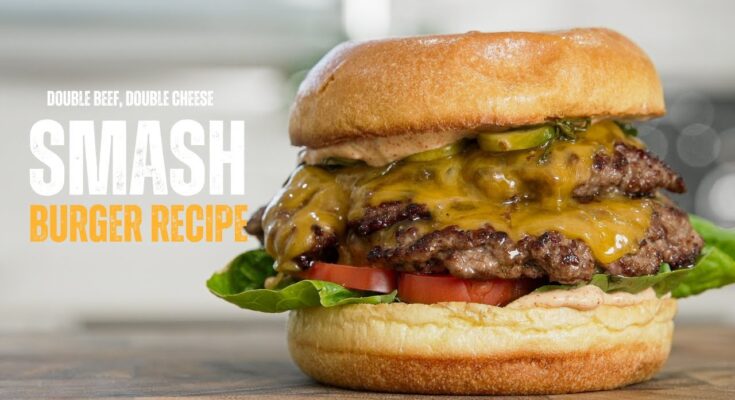Black Bean Burgers Recipe: If you’re craving a hearty burger but want something healthier and plant-based, black bean burgers are the perfect answer. Unlike processed veggie patties you find in the frozen aisle, homemade black bean burgers pack real flavor, texture, and nutrition. Black beans are naturally high in protein, fiber, and antioxidants, making them an excellent replacement for meat without compromising taste.
What makes black bean burgers truly special is their versatility. You can season them in endless ways—spicy with chipotle peppers, smoky with paprika, or savory with garlic and herbs. They pair well with almost any topping, from classic lettuce and tomato to gourmet avocado and caramelized onions. Plus, they’re filling enough to satisfy even the biggest burger lover.
If you’ve ever tried making veggie burgers at home, you might have struggled with them falling apart or turning mushy. Don’t worry—this step-by-step guide will show you exactly how to make black bean burgers that hold together, taste amazing, and cook up beautifully on the stovetop, in the oven, or even on the grill. Let’s get started!
Ingredients You’ll Need
When it comes to making the best black bean burgers, ingredients matter. The goal is to strike a balance between flavor, texture, and moisture so that your patties stay firm yet juicy. Here’s a breakdown of what you’ll need:
Main Ingredients
- Black beans (2 cans, drained and rinsed or 3 cups cooked) – the star of the show
- Breadcrumbs or oats (½ cup) – for binding the patties
- Egg (1 large, or flax egg for vegan option) – helps hold everything together
- Onion (½ cup finely chopped) – adds flavor and moisture
- Garlic cloves (2, minced) – gives depth of flavor
- Bell pepper (½ cup diced) – optional, adds a slight sweetness
Optional Add-Ins for Flavor
- Cumin (1 teaspoon) – for warmth and earthiness
- Smoked paprika (1 teaspoon) – adds a smoky, BBQ-like flavor
- Chili powder or chipotle powder (½ teaspoon) – for heat
- Fresh cilantro or parsley (2 tablespoons, chopped) – for freshness
- Shredded cheese (optional) – for extra richness
Condiments and Toppings
- Burger buns (whole wheat, brioche, or gluten-free)
- Lettuce, tomato, onion slices
- Pickles, avocado, or jalapeños
- Sauces like ketchup, mustard, mayo, BBQ, or chipotle aioli
Having these ingredients ready before you begin makes the cooking process smoother and ensures you can shape the patties without interruption.
Step-by-Step Guide to Making Black Bean Burgers
Now comes the fun part—actually putting everything together. The process is simple, but each step plays a big role in getting the right texture and flavor.
Step 1 – Preparing the Black Beans
Start by draining and rinsing your black beans. Spread them out on a baking sheet lined with paper towels and pat them dry. If they’re too wet, your patties will be mushy. Some cooks even roast the beans in the oven at 350°F (175°C) for 10–15 minutes to remove extra moisture.
Once dried, place the beans in a large mixing bowl. Mash them with a fork or potato masher, leaving some beans whole for texture. Avoid pureeing them completely—you want a chunky mixture, not a paste.
This step is the foundation of your burger, so take your time. A well-prepped bean base ensures your patties hold together beautifully.
Step 2 – Mixing the Ingredients
Now that your beans are ready, add in the chopped onion, garlic, bell pepper, and any optional herbs or spices you like. Sprinkle in the breadcrumbs or oats, then crack in the egg (or flax egg for a vegan version).
Using a wooden spoon or your hands, mix everything together until the ingredients are evenly distributed. If the mixture feels too wet, add more breadcrumbs a tablespoon at a time until it holds its shape. If it’s too dry, splash in a little olive oil or water.
The key here is balance. You want a mixture that binds together when pressed but doesn’t stick excessively to your hands. Think of it like cookie dough—you should be able to scoop and form it easily.
At this stage, you can taste the mixture (before adding egg, if you’re worried about raw ingredients) to adjust seasonings. Add extra cumin for earthiness, chili powder for spice, or smoked paprika for depth.
Step 3 – Shaping the Patties
Once your mixture is ready, divide it into 4–6 equal portions, depending on how large you want your burgers. Wet your hands slightly to prevent sticking, then roll each portion into a ball before flattening into a patty about ¾-inch thick.
Try to keep the patties uniform in size so they cook evenly. Place them on a parchment-lined baking sheet as you shape them. If your mixture is still a little sticky, chill the patties in the fridge for 20–30 minutes before cooking. This extra step helps them firm up and prevents falling apart later.
Think of shaping patties like crafting mini sculptures—you’re not just slapping ingredients together, you’re building the foundation for a delicious burger experience.
Step 4 – Cooking Methods (Stovetop, Oven, Grill)
Cooking black bean burgers is flexible because you can prepare them in multiple ways depending on your kitchen setup and personal preference. Each method has its perks, so let’s break them down:
Stovetop Method
Heat 1–2 tablespoons of oil (olive oil or vegetable oil works great) in a large skillet over medium heat. Once hot, place the patties in the pan and cook for about 4–5 minutes per side until crispy and golden brown. This method gives your burgers a nice crust while keeping the inside soft and flavorful.
Pro tip: Avoid flipping too often. Let the patties cook fully on one side before turning, so they don’t crumble.
Oven-Baked Method
If you’re looking for a healthier, oil-free option, baking is the way to go. Preheat your oven to 375°F (190°C). Place the patties on a parchment-lined baking sheet, then bake for 10–12 minutes per side (20–25 minutes total).
This method makes the patties slightly firmer, perfect for meal prep and freezing.
Grill Method
Yes, you can grill black bean burgers! Preheat your grill to medium heat and brush the grates with oil to prevent sticking. Place patties on the grill and cook for about 4–5 minutes per side.
Because black bean burgers are softer than meat, handle them gently and consider using a grill mat or foil to prevent them from falling apart. The result is a smoky, charred flavor that rivals traditional beef burgers.
No matter which method you choose, the goal is to create a crisp outer layer with a tender, flavorful inside.
Step 5 – Assembling Your Burger
Now comes the most satisfying step—putting it all together! Think of this like building your dream burger.
Choose the Right Bun
The bun sets the stage for the whole burger. Whole wheat buns are a healthier choice, brioche buns add a buttery sweetness, and gluten-free buns work for those with sensitivities. Toasting the bun lightly in the oven or skillet adds crunch and prevents sogginess.
Layering Your Ingredients
Start with your bottom bun, then add a spread of sauce—mayo, BBQ sauce, chipotle aioli, or mustard all work great. Next, place your black bean patty. Stack on fresh toppings like lettuce, tomato slices, onions, avocado, or pickles. Finish with another sauce layer before topping with the bun.
Creative Burger Ideas
- Tex-Mex Style: Add guacamole, salsa, and jalapeños.
- Classic Diner Style: Stick to lettuce, tomato, onion, and ketchup.
- Gourmet Style: Top with caramelized onions, arugula, and garlic aioli.
The beauty of black bean burgers is that they’re a blank canvas. Whether you want a classic burger or something unique, you can stack it just the way you like.
Tips for the Perfect Black Bean Burger
Even though black bean burgers are simple to make, there are a few tricks to get them perfect every time.
Preventing Soggy Burgers
The biggest complaint about homemade veggie burgers is that they can get mushy. To avoid this, make sure your beans are dried thoroughly before mashing. Roasting them briefly in the oven is a game changer. Adding the right amount of breadcrumbs or oats also soaks up extra moisture.
Binding Ingredients Effectively
Without proper binding, the patties fall apart. Egg works best, but for a vegan option, use a flax egg (1 tablespoon ground flaxseed + 3 tablespoons water). Refrigerating the shaped patties before cooking also helps them stay intact.
Spices and Flavor Boosters
Don’t be shy with seasoning. Black beans alone can be mild, so spices like cumin, smoked paprika, garlic powder, or chili powder bring life to the burger. Fresh herbs like cilantro or parsley add freshness, while a splash of lime juice brightens everything up.
Remember: A black bean burger isn’t trying to imitate meat—it has its own unique taste and texture. Lean into that and build bold flavors.
Variations of Black Bean Burgers
One of the best things about black bean burgers is how customizable they are. You can experiment with different add-ins to suit your taste.
Vegan Black Bean Burger
Skip the egg and use a flax egg instead. For extra binding power, add mashed sweet potato or cooked quinoa. These not only help hold the patties together but also add richness and nutrients.
Spicy Chipotle Black Bean Burger
Add chopped chipotle peppers in adobo sauce to the mixture along with smoked paprika. The result is a smoky, spicy burger with a bold kick. Pair it with avocado slices and a creamy chipotle mayo for balance.
Black Bean and Quinoa Burger
Quinoa gives the patties more texture and protein. Mix 1 cup of cooked quinoa into your black bean mixture along with your usual ingredients. This version is especially hearty and makes for a more filling burger.
Other fun variations include adding shredded cheese to the mix, tossing in corn kernels for sweetness, or even folding in mushrooms for an umami boost.
Serving Suggestions
A burger is never complete without sides and pairings. Here’s how to create the ultimate black bean burger meal:
Best Buns for Black Bean Burgers
- Brioche buns for a soft, buttery touch
- Whole grain buns for a healthy option
- Lettuce wraps for a low-carb alternative
Delicious Side Dishes
- Sweet potato fries – crispy and naturally sweet
- Coleslaw – adds crunch and freshness
- Grilled veggies – a light, colorful side
- Potato salad or quinoa salad – hearty and filling
Healthy Topping Combinations
Instead of just ketchup and mustard, play around with toppings:
- Avocado + salsa + jalapeños for a Tex-Mex twist
- Hummus + roasted red peppers + spinach for a Mediterranean vibe
- Caramelized onions + arugula + goat cheese for a gourmet flair
The right sides and toppings take your burger from “just dinner” to a complete, restaurant-worthy meal.
Storing and Reheating Black Bean Burgers
One of the biggest advantages of black bean burgers is that they’re meal-prep friendly. You can make a big batch at once and enjoy them throughout the week or even freeze them for later. Here’s how to store them the right way:
Storing in the Fridge
If you plan to eat the burgers within 3–4 days, simply let them cool to room temperature after cooking, then place them in an airtight container. Layer parchment paper between patties so they don’t stick together. Reheat them in a skillet over medium heat for 3–4 minutes per side, or pop them in the oven at 350°F (175°C) until warmed through.
Freezing for Meal Prep
For longer storage, freezing is your best bet. Shape the patties but don’t cook them yet. Place them on a baking sheet lined with parchment paper and freeze until firm. Once solid, transfer them to a freezer-safe bag with parchment between each patty. They’ll last up to 3 months.
When you’re ready to eat, thaw them in the fridge overnight before cooking, or cook directly from frozen—just add a couple of extra minutes to the cooking time.
Best Reheating Methods
- Skillet: Best for crisping up the outside.
- Oven: Even reheating without drying them out.
- Microwave: Quick, but may make them softer—wrap in a paper towel to absorb excess moisture.
Proper storage means you’ll always have a healthy, homemade burger ready to go.
Nutritional Value of Black Bean Burgers
Black bean burgers aren’t just delicious—they’re also packed with nutrients. If you’re looking for a healthier burger option, here’s why these should be your go-to:
Calories and Macros
A standard homemade black bean burger patty (without toppings or buns) typically contains:
- Calories: 180–220
- Protein: 10–12g
- Fiber: 8–10g
- Fat: 3–5g (depending on add-ins)
- Carbs: 25–30g
High Protein and Fiber Benefits
The combination of black beans, oats, and optional quinoa provides both protein and complex carbs, making this a filling meal that keeps you satisfied for hours. The high fiber content supports digestion and helps regulate blood sugar levels.
Comparison with Beef Burgers
A traditional beef burger patty of the same size usually contains around 300–350 calories, 20g of fat, and almost no fiber. While beef provides more protein, black bean burgers are significantly lower in fat and cholesterol, making them a heart-healthy choice.
These burgers are proof that you don’t have to sacrifice taste to eat healthier—you’re getting plenty of nutrients with every bite.
Common Mistakes to Avoid
Even experienced cooks can run into problems with black bean burgers. Here are the most common pitfalls and how to avoid them:
Over-Processing the Beans
If you mash or blend the beans into a paste, your patties will turn out dense and mushy. Instead, leave some beans whole for texture. Think chunky, not creamy.
Using Too Much Liquid
Adding too many wet ingredients like sauces, raw veggies, or eggs can make the mixture too soft. Always balance with dry ingredients like breadcrumbs or oats to firm things up.
Skipping Resting Time
Black bean patties benefit from chilling in the fridge for at least 20–30 minutes before cooking. This step helps them firm up and hold their shape better during cooking.
Flipping Too Early
When cooking on the stovetop or grill, patience is key. If you flip too soon, the patties may fall apart. Let them cook undisturbed on one side until golden and crispy before flipping.
Avoiding these mistakes ensures that every batch of black bean burgers comes out restaurant-quality.
FAQs about Black Bean Burgers Recipe
1. Can I freeze black bean burger patties?
Yes! Freeze uncooked patties on a baking sheet, then transfer them to a freezer bag with parchment between each patty. They’ll last up to 3 months.
2. How do I make my burger less mushy?
Dry your beans thoroughly, avoid over-mashing, and add enough breadcrumbs or oats for structure. Refrigerating the patties before cooking also helps.
3. Are black bean burgers gluten-free?
Yes, as long as you use gluten-free oats or breadcrumbs and pair them with gluten-free buns or lettuce wraps.
4. What beans can I substitute for black beans?
You can use kidney beans, pinto beans, or chickpeas for a slightly different flavor and texture.
5. Can I cook black bean burgers on the grill?
Absolutely! Just handle them gently and consider using foil or a grill mat to prevent sticking.
Conclusion
By following this step-by-step guide, you’ll learn how to prepare beans properly, season the patties for maximum flavor, cook them using different methods, and assemble the burger of your dreams. Plus, with the tips on storage and variations, you’ll never get bored of eating them.
So, next time you’re craving a burger, skip the takeout and whip up your own black bean masterpiece. Your taste buds—and your body—will thank you.



